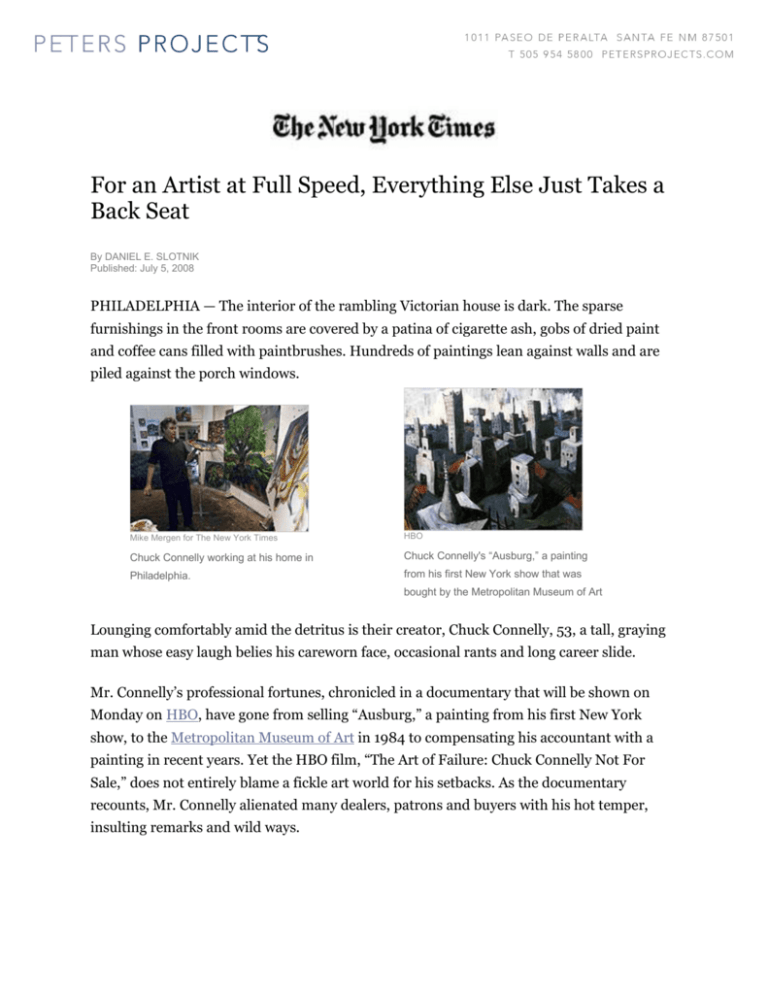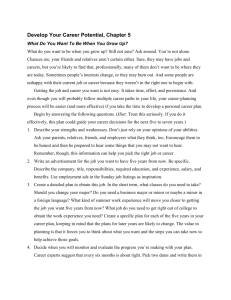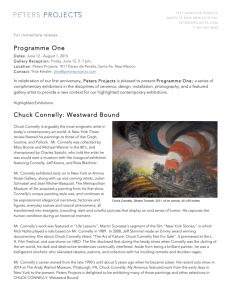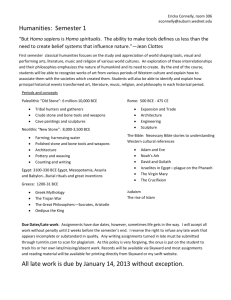PDF - Peters Projects
advertisement

For an Artist at Full Speed, Everything Else Just Takes a Back Seat By DANIEL E. SLOTNIK Published: July 5, 2008 PHILADELPHIA — The interior of the rambling Victorian house is dark. The sparse furnishings in the front rooms are covered by a patina of cigarette ash, gobs of dried paint and coffee cans filled with paintbrushes. Hundreds of paintings lean against walls and are piled against the porch windows. Mike Mergen for The New York Times HBO Chuck Connelly working at his home in Chuck Connelly's “Ausburg,” a painting Philadelphia. from his first New York show that was bought by the Metropolitan Museum of Art in 1984. Lounging comfortably amid the detritus is their creator, Chuck Connelly, 53, a tall, graying man whose easy laugh belies his careworn face, occasional rants and long career slide. Mr. Connelly’s professional fortunes, chronicled in a documentary that will be shown on Monday on HBO, have gone from selling “Ausburg,” a painting from his first New York show, to the Metropolitan Museum of Art in 1984 to compensating his accountant with a painting in recent years. Yet the HBO film, “The Art of Failure: Chuck Connelly Not For Sale,” does not entirely blame a fickle art world for his setbacks. As the documentary recounts, Mr. Connelly alienated many dealers, patrons and buyers with his hot temper, insulting remarks and wild ways. Mr. Connelly has mixed feelings about the film. “They only had the worst shots of me, they only shot when I was drunk,” he said. He added that he was “not a failure like the movie says.” But he is pleased that the documentary features a good deal of his work, whose variety includes brooding scenes that suggest a blend of Goya and Rockwell; mythological subjects; landscapes; portraits; and handbags painted from magazines. Mr. Connelly also said he recognized “a certain heroic quality” in the portrayal and described the movie as “a story of perseverance, destiny, discipline.” In many ways the film’s director, Jeff Stimmel, agrees. Mr. Connelly is “really committed to doing his art, no matter whether there’s an audience,” Mr. Stimmel said. In fact, he added, Mr. Connelly’s drive inspired him to persevere when studios responded lukewarmly to his proposal. Born into a working-class family in Pittsburgh in 1955, Mr. Connelly graduated from the Tyler School of Art in Philadelphia in 1977 and then headed to New York, where Dr.Robert C. Atkins, the creator of the Atkins diet, became his patron. With Dr. Atkins’s support, Mr. Connelly spent two years in Germany developing his work before returning to New York in the early ’80s. He was picked up by the Annina Nosei Gallery and before long was rubbing shoulders with hot artists of that decade, like Julian Schnabel and Jean-Michel Basquiat. In 1989 his work was even featured in “Life Lessons,” Martin Scorsese’s segment of the film “New York Stories,” in which Nick Nolte played a role based on Mr. Connelly. Yet as he gained a reputation for being difficult, Mr. Connelly’s career waned in the 1990s. He sparred with gallery owners and their clients. He was thrown out of many downtown bars. He infuriated Mr. Scorsese and the cast of “New York Stories” by telling The New York Post’s gossip column, Page Six, that he found the film “mundane” and “clichéd.” By 1999, financial troubles and the toll of hard living in New York led Mr. Connelly and his wife at the time, Laurence Groux, to move to East Oak Lane, part of a tranquil neighborhood of rundown Victorian dwellings in Philadelphia. By then he was represented by the Lennon, Weinberg Gallery in New York, where he met Mr. Stimmel, the film director, three years later. Mr. Stimmel, another Pittsburgh native and a graduate of the University of Pittsburgh film school, filmed Mr. Connelly from 2002 to 2007. Scenes show his alcoholic rages and his unusual ploy of hiring a mild-mannered actor to shop his paintings around, giving the artist’s name as Fred Scaboda. But Mr. Stimmel predicts that television viewers will be attracted to Mr. Connelly’s resolve “to be his own man” and to his uncompromising nature, even when those qualities seem self-defeating. The documentary was screened at the National Arts Club in Manhattan on June 17, concurrent with shows of Mr. Connelly’s work at the DFN Gallery in Chelsea (through July 18) and at the New Arts Gallery in Litchfield, Conn. (through July 14). Mr. Connelly said he detested most of the work currently favored by the contemporary-art world. When he visits New York, he said, he avoids the booming gallery district in Chelsea because “it’s sad.” “The greatest passion of my life is something that makes me sick to my stomach,” he said in a recent interview. The current scene “has become this commercial venture, hyped-up thing,” he added. Still, he is friendly with some up-and-coming painters. He said his assistant, Mark Ellis, and other Tyler Art School graduates come to his home to paint and criticize one another’s work. He mentioned that he might start an informal art school, “like the Philadelphia Eight with Robert Henri,” referring to the Ashcan School painter who taught Edward Hopper and Rockwell Kent. Those who know Mr. Connelly well agree that the maniacal outbursts recorded in the film are countered by his charm and his art. “When I saw his painting, I saw inside his soul, and that’s what I fell in love with,” said Ms. Groux, from whom he is divorced. “The things that he didn’t want to show outside, I could see in his painting.” Ms. Groux left Mr. Connelly in 2005 because she could no longer tolerate his behavior, she said, but added that she forgives him. “Chuck is so angry because he’s a very pure heart,” she said. “There are a lot of things he’s seeing around him that just drive him crazy.” She mused that the early acclaim he won might have led to problems, likening him to a child actor whose “life is never the same after that.” The film may be a career boost. Rick Davidman, president of the DFN Gallery, said it had sold seven of Mr. Connelly’s paintings since the documentary was screened in June and its HBO broadcast was publicized, more than at the artist’s past exhibitions. Mr. Stimmel said that at least one studio had expressed interest in making a feature film inspired by the documentary. Asked who should play him, Mr. Connelly said that he would like “someone successful, like Brad Pitt or Gary Cooper.” “Maybe I could play Nick Nolte,” he said with a chuckle.






